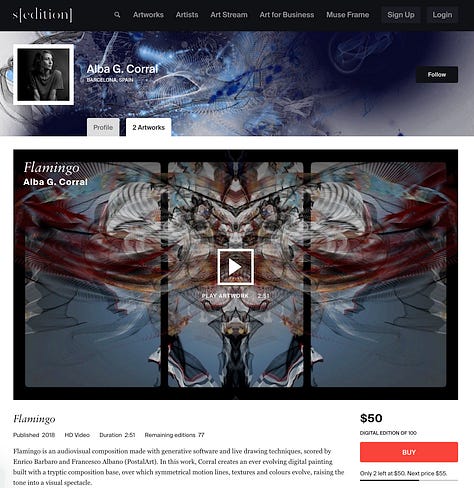AI + Art = The Missing Link
Art is our genetic legacy, but there's a problem. We don't have enough walls to hang all our stuff. We need to evolve a new link, a new way to exhibit.
Human creations visualize the evolutionary process.
Like evolution, artists gradually discard ideas that no longer work, constantly test new ones, and quickly fill in emerging terrain with innovative experiments.
Art is an affirmation of life, but there's a problem. We don't have enough walls or space to hang and display all the stuff people have made and continue to make. And now, computational art, with its limitless iterations, is adding to the glut.
Worldwide, there are roughly 55,000 museums, and while they care for the art they own, most of it is hidden from view. The Metropolitan Museum of Art in New York, for example, currently owns 1.5 million objects covering 5,000 years of human creativity. Yet they only show around 20,000 items at a time. The rest, 90%, is locked up in 105,000 square feet of onsite storage, plus four off-site facilities. The city of London is home to 200 museums. How many priceless artifacts have they hidden away? And what about all the homeless art?
The art market makes a superhuman effort to show and sell. Every year, there are between 300 and 400 art fairs in cities worldwide, with some hosting hundreds of galleries. Plus, most cities feature art galleries. New York City, arguably the center of the art world, has roughly 1400 galleries. And what about creative professionals who aren't represented or amateurs who may never exhibit? Their art is piling up in studios, garages, and guest bedrooms.
Over the years, I have had the opportunity to see the homes of some great collectors. Their taste in art is incredible, but their decor is often neo-horde-ish. They fill their walls with so many demanding images the art becomes intrusive and the rooms claustrophobic.
Art is a form of communication. We don't simply see it; we understand it or try to.
Our first intentional marks were imbued with meaning. Art gave birth to symbolic picograms, which evolved into letters, which in turn formed words that scribes ultimately arranged into easy-to-read grammatical text. Then came the printing press. Each step in the process moved knowledge from small groups to larger groups. As more people gained the ability to read and write, humanities knowledge leaped forward. Art, too, stimulates human intelligence. What if all that art we have was easier to access?
Enter s(edition), a platform that presents videos and still images of computational art.
On the site, you can view a limited range of art for free or subscribe for a reasonable fee and select the art you prefer from their extensive collection. You can also collect it. The art is digital and remains on the s(edition) site, but you can cast a running loop of your selections to TVs, phones, and tablets. Their artists include both established stars and emerging talents, and the styles range widely.



What I like best is the site's ability to replicate some of the most compelling aspects of the physical art world. Things like curating your own collection, which you can choose to share on the site. The buying process is competitive because the works, though quite affordable, are limited editions. You can resell your pieces when the editions run out. You can also follow the artists and see who's acquiring them. This level of personal engagement and intellectual stimulation is what the art world, at its best, is all about.
What if museums, galleries, and artists expanded their digital and analog collections onto the s(edition) model to give the public access to their hidden treasure troves?
We use technology to make art. Why not use technology to spread the experience of seeing and appreciating art? The cost of making art digitally available is a fraction of the money being left on the table by not allowing humans access to the inspiration and conceptual development that art naturally conveys.




S(edition) was invented and launched in 2011 by Harry Blain and Robert L. Norton, both recognized leaders in contemporary art. Now run by Rory Blain and a small team of art professionals, the site is a remarkable breakthrough in accessibility. If you're curious, I recommend browsing their site menu and video presentations.
We have all this art floating around us. If we give people the chance to see it and curate their own stories and experiences, will it generate spontaneous leaps of innovation? Let's find out. Let's utilize technology to create a better way for humans to access their inventive genetic legacy. Evolution through art.
Thank you for your interest. - Julia Morton AIplusArt.com





